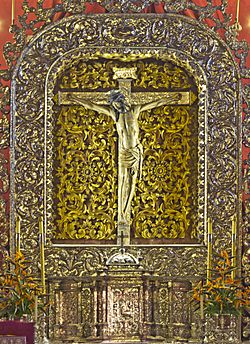Cristo de La Laguna facts for kids
Quick facts for kids Christ of La Laguna |
|
|---|---|
| Spanish: Santísimo Cristo de La Laguna | |
 |
|
| Artist | Louis Van Der Vule |
| Year | 1510 - 1514 |
| Type | Wood |
| Location | Real Santuario del Santísimo Cristo de La Laguna |
The Christ of La Laguna (or Santísimo Cristo de La Laguna in Spanish) is a famous wooden statue of Jesus on the cross. You can find it in the Royal Sanctuary of the Christ in the city of San Cristóbal de La Laguna. This city is located on the island of Tenerife, which is part of the Canary Islands in Spain.
This statue is the most respected image of Jesus in the Canary Islands. Many people believe it is one of the most beautiful religious sculptures in Spain. It is also considered one of the most important artworks showing the Crucifixion of Jesus in all of Europe.
Contents
The Story of the Christ Statue
People have different ideas about where the Christ statue came from. Professor Joaquin Yarza thought it might have come from northern Europe. However, he also considered that it could have come from Seville, a city in Spain.
Newer studies by Professor Francisco Galante Gomez suggest the statue was made in the busy workshops of Antwerp. This means it likely came from the Flemish-Brabanzon region. It was probably carved by an artist named Louis Van Der Vule around the year 1514.
Some stories say the statue traveled a lot before reaching Tenerife. It might have gone to Venice, a big trading city, first. From there, it could have traveled to Barcelona and then to Cádiz in Spain. It even stayed for a short time in a church in Sanlúcar de Barrameda. Finally, the statue arrived in Tenerife in 1520.
Over many centuries, people have shown great respect for this statue. This has made it one of the most honored religious images in the Canary Islands. The statue has been carried in special parades through the city many times. People would often ask for its help during difficult times, like when there were sicknesses, plagues, or droughts on the island of Tenerife.
On September 21, 1947, a special event happened. Monsignor Domingo Pérez Cáceres officially blessed the Christ of La Laguna statue. He was the first bishop born in Tenerife to lead his home diocese. For this important occasion, the statue was moved to the Cathedral of La Laguna a few days before.
Today, the church where the Christ statue is kept is called a Royal Sanctuary. It is very popular with people who go to church. The church is now looked after by the Franciscan community. This community is next to the Convent of San Miguel de las Victorias. Throughout history, Popes have given special blessings to this church, similar to those given to the Basilica of St. John Lateran in Rome. In 2005, the government of the Canary Islands officially recognized the "Real Santuario del Santísimo Cristo de La Laguna" as an important Cultural Monument.
The festival celebrating the Christ of La Laguna happens every year on September 14.
Cool Legends About Its Origin
There are some interesting old stories that try to explain how this mysterious statue came to be.
One legend says that the Christ of La Laguna statue was carved by angels. Another story even claims that Saint Luke, who wrote one of the Gospels, sculpted it! A person named Fray Luís de Quirós believed that Saint Michael the Archangel brought the statue to Tenerife. In these legends, the "holy sculptors" made the statue look exactly like Jesus Christ did when he was crucified.
Another exciting legend tells of a stormy night. The religious people at the Convent of San Miguel de las Victorias (which is now the Sanctuary of Christ) heard a knock at their door. When they opened it, they found a large box. Bright lights were shining from inside the box! After they opened the box, they found the statue of Christ. Everyone thought this was a true miracle.
The Brotherhood of Christ of La Laguna
A special group called a "brotherhood" or "sorority" takes care of the Christ statue. This group is the largest of its kind in the Canary Islands. Its full name is: Pontificia, Real y Venerable Esclavitud del Santísimo Cristo de La Laguna.
This brotherhood has received special honors. The Spanish King Alfonso XIII gave it the title of "Royal" on December 19, 1906. Later, Pope Pius X gave it the title of "Pontifical" on February 15, 1908.
Gallery
See also
 In Spanish: Santísimo Cristo de La Laguna para niños
In Spanish: Santísimo Cristo de La Laguna para niños
- List of statues of Jesus
- San Cristóbal de La Laguna
- Real Santuario del Santísimo Cristo de La Laguna
- Virgin of Candelaria




